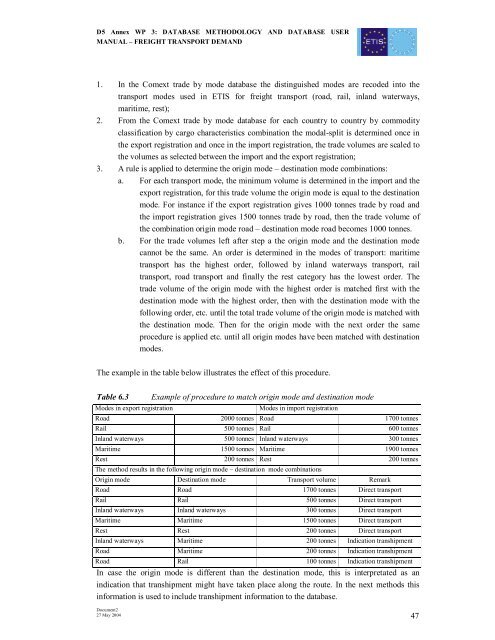D5 Annex report WP 3: ETIS Database methodology ... - ETIS plus
D5 Annex report WP 3: ETIS Database methodology ... - ETIS plus
D5 Annex report WP 3: ETIS Database methodology ... - ETIS plus
You also want an ePaper? Increase the reach of your titles
YUMPU automatically turns print PDFs into web optimized ePapers that Google loves.
<strong>D5</strong> <strong>Annex</strong> <strong>WP</strong> 3: DATABASE METHODOLOGY AND DATABASE USER<br />
MANUAL – FREIGHT TRANSPORT DEMAND<br />
1. In the Comext trade by mode database the distinguished modes are recoded into the<br />
transport modes used in <strong>ETIS</strong> for freight transport (road, rail, inland waterways,<br />
maritime, rest);<br />
2. From the Comext trade by mode database for each country to country by commodity<br />
classification by cargo characteristics combination the modalsplit is determined once in<br />
the export registration and once in the import registration, the trade volumes are scaled to<br />
the volumes as selected between the import and the export registration;<br />
3. A rule is applied to determine the origin mode – destination mode combinations:<br />
a. For each transport mode, the minimum volume is determined in the import and the<br />
export registration, for this trade volume the origin mode is equal to the destination<br />
mode. For instance if the export registration gives 1000 tonnes trade by road and<br />
the import registration gives 1500 tonnes trade by road, then the trade volume of<br />
the combination origin mode road – destination mode road becomes 1000 tonnes.<br />
b. For the trade volumes left after step a the origin mode and the destination mode<br />
cannot be the same. An order is determined in the modes of transport: maritime<br />
transport has the highest order, followed by inland waterways transport, rail<br />
transport, road transport and finally the rest category has the lowest order. The<br />
trade volume of the origin mode with the highest order is matched first with the<br />
destination mode with the highest order, then with the destination mode with the<br />
following order, etc. until the total trade volume of the origin mode is matched with<br />
the destination mode. Then for the origin mode with the next order the same<br />
procedure is applied etc. until all origin modes have been matched with destination<br />
modes.<br />
The example in the table below illustrates the effect of this procedure.<br />
Table 6.3<br />
Modes in export registration<br />
Example of procedure to match origin mode and destination mode<br />
Modes in import registration<br />
Road 2000 tonnes Road 1700 tonnes<br />
Rail 500 tonnes Rail 600 tonnes<br />
Inland waterways 500 tonnes Inland waterways 300 tonnes<br />
Maritime 1500 tonnes Maritime 1900 tonnes<br />
Rest 200 tonnes Rest 200 tonnes<br />
The method results in the following origin mode – destination mode combinations<br />
Origin mode Destination mode Transport volume Remark<br />
Road Road 1700 tonnes Direct transport<br />
Rail Rail 500 tonnes Direct transport<br />
Inland waterways Inland waterways 300 tonnes Direct transport<br />
Maritime Maritime 1500 tonnes Direct transport<br />
Rest Rest 200 tonnes Direct transport<br />
Inland waterways Maritime 200 tonnes Indication transhipment<br />
Road Maritime 200 tonnes Indication transhipment<br />
Road Rail 100 tonnes Indication transhipment<br />
In case the origin mode is different than the destination mode, this is interpretated as an<br />
indication that transhipment might have taken place along the route. In the next methods this<br />
information is used to include transhipment information to the database.<br />
Document2<br />
27 May 2004<br />
47
















